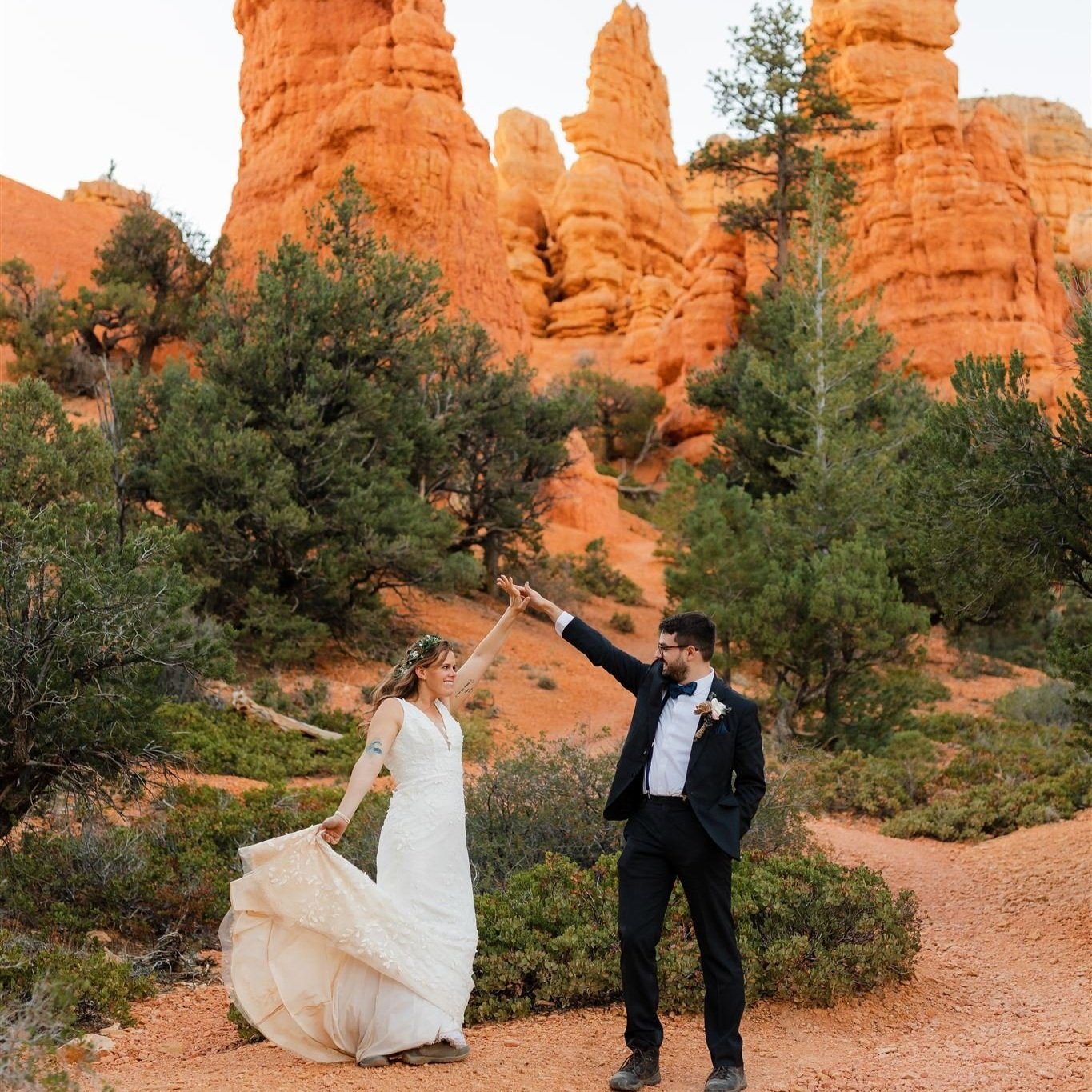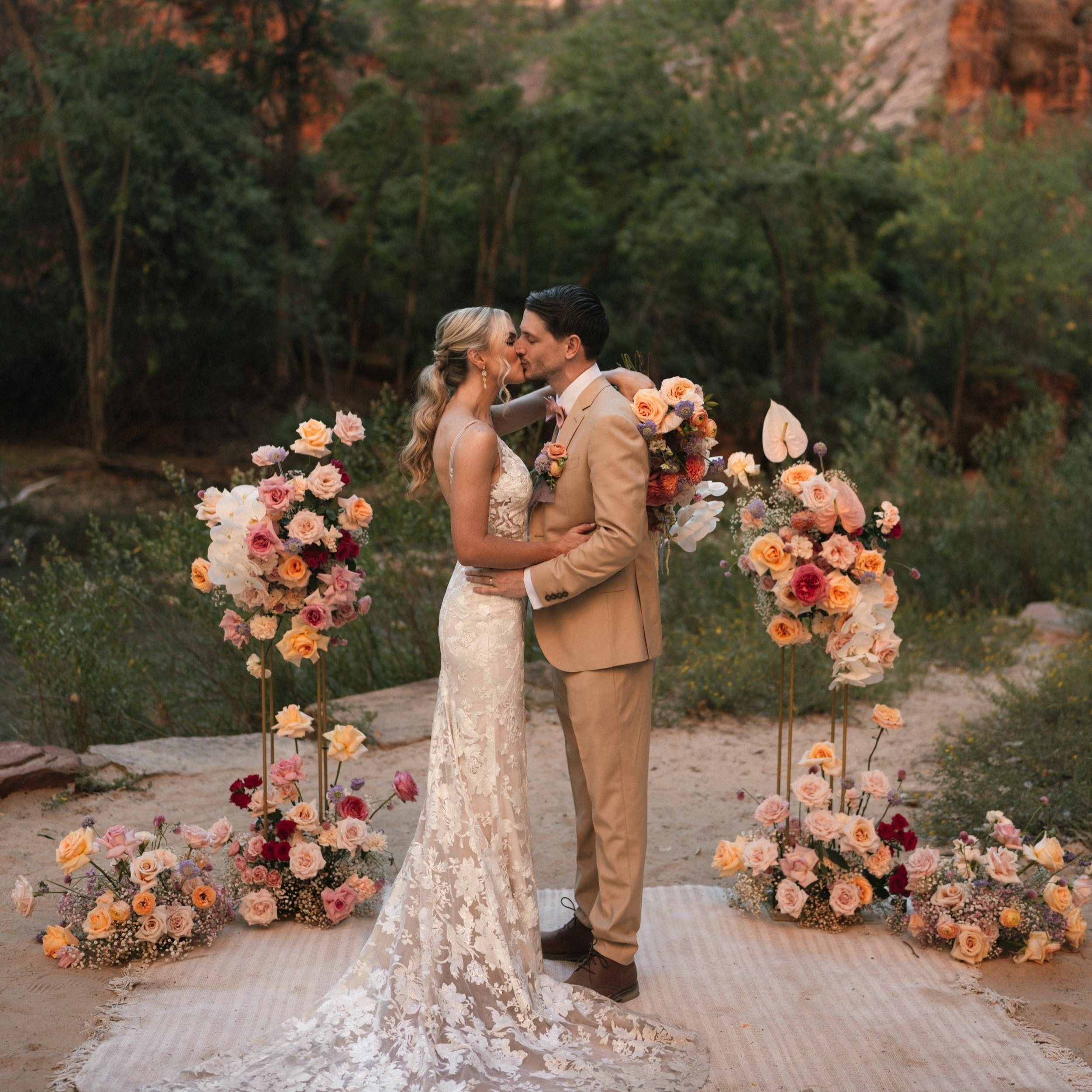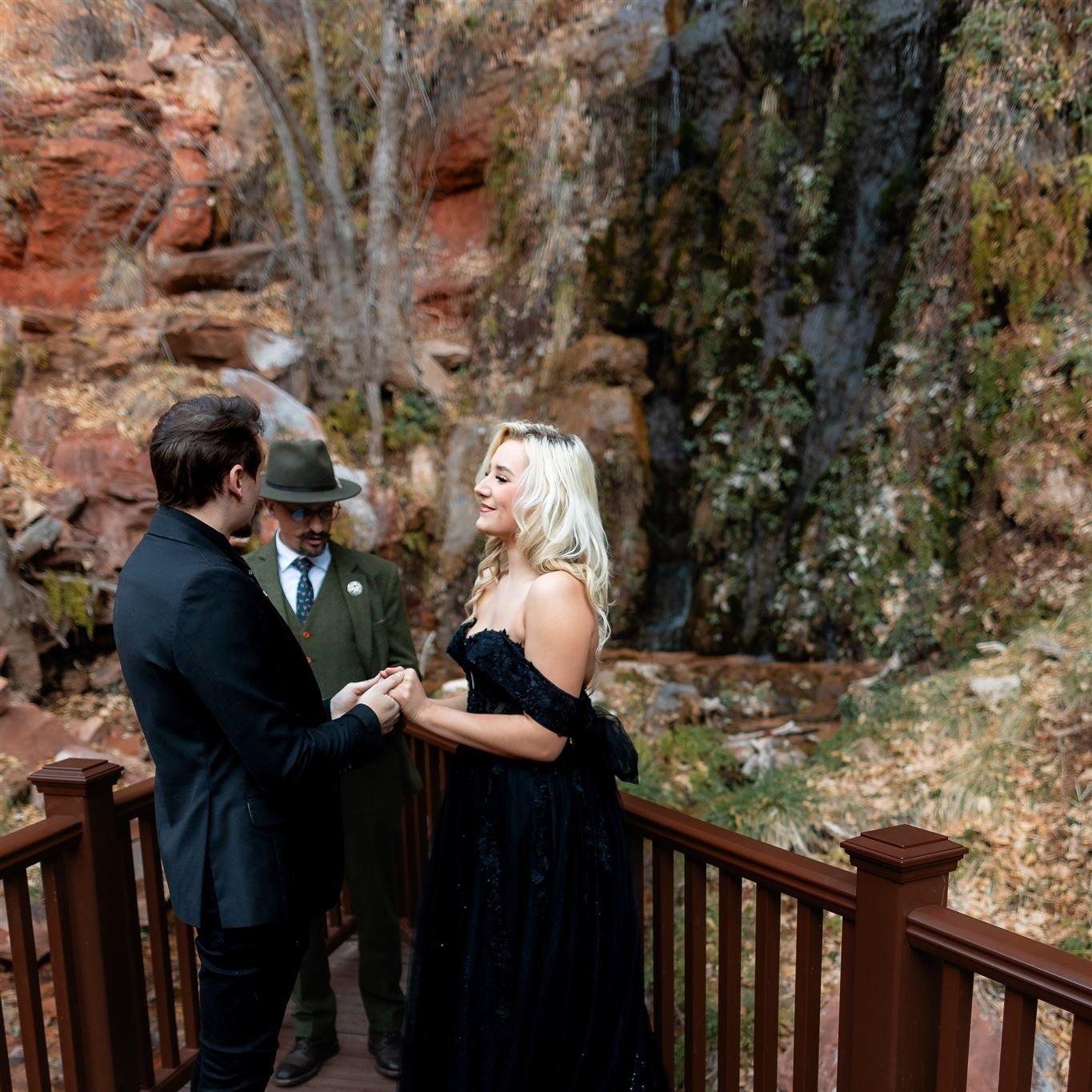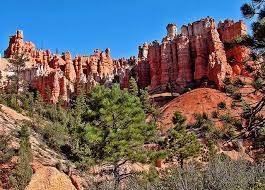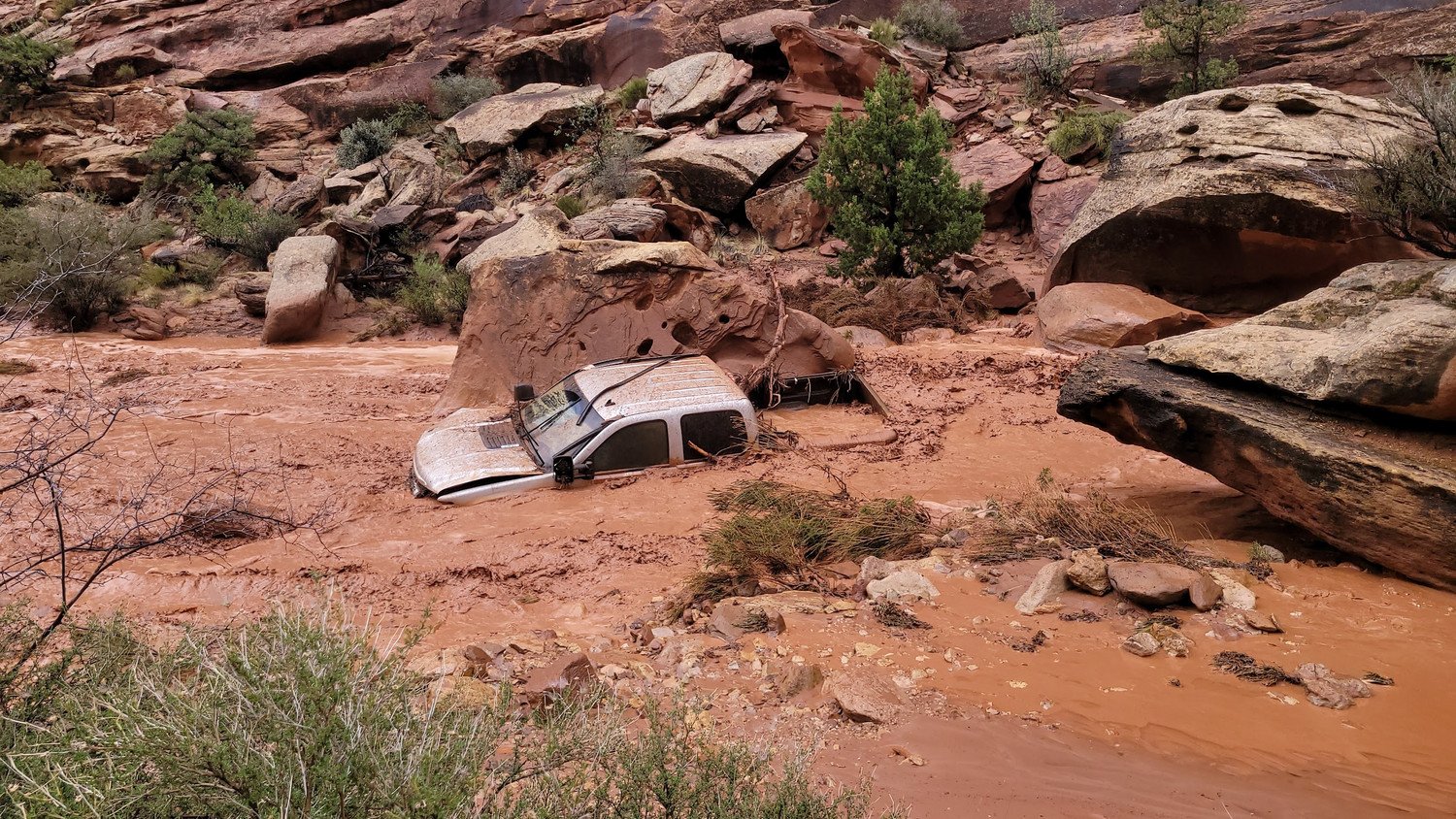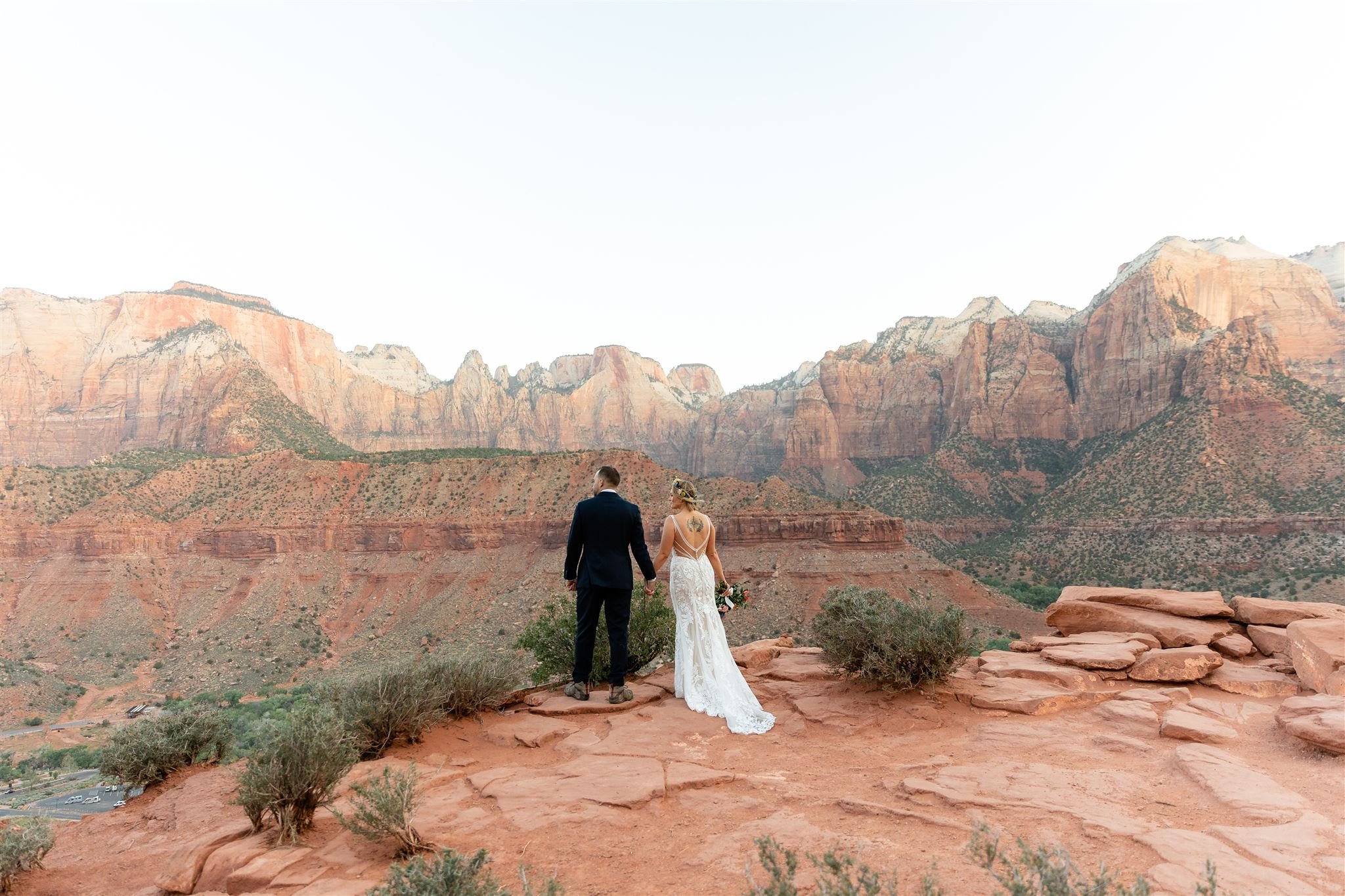
ZION AND BRYCE CANYON
ELOPEMENT
LOCATIONS
ZION ELOPEMENT LOCATIONS.
BRYCE CANYON
ELOPEMENT LOCATIONS.
LOCATIONS IN ZION NATIONAL PARK, APPROVED FOR WEDDINGS:
Temple of Sinawava
Menu Falls
South Campground Amphitheater
Nature Center North Lawn
Zion Lodge Lawn
Timber Creek Overlook
Photo by Kassie Gunn
Temple of Sinawava
Accommodates a max of 35 people. The road to it is closed to cars during some months. When closed to automobiles the use of the shuttle system will take you and your guests, this can add several hours to the trip and to the hours you will need to pay your vendors such as photographers.
Menu Falls
Accommodates a max of 10 people. The ten people include the couple, officiant, photographer(s), and guests. When regular park visitors are added to the location it is a tight fit. I recommend this location only for the smallest elopements.
South Campground Amphitheater
Accommodates a max of 100 people. It has the same parking lots as the Nature Center and is likewise near the main west entrance to the park and is accessible. The other main upsides to this location is it has sidewalk all the way from the parking lot and is the only location with built in seating. Bleacher style benches face the amphitheater stage.
photo by Kyle Loves Tori Photography
Nature Center North Lawn
Accommodates a max of 50 people and is only available November until early April. When this location is available it is one of my top suggestions in the park. One of the best (least used) parking lots and its closeness to the main west entrance makes it more accessible than most of the locations. It has a great view as a backdrop.
Photo by Kyle Loves Tori Photography
Zion Lodge Lawn
Accommodates a max of 75 people. This location is ONLY the lawn and use of the lodge facilities will need to be coordinated with the lodge. Like the Temple of Sinawava, the road to it is closed to cars during some months. Anyone staying overnight at the lodge will be able to drive their vehicle.
Timber Creek Overlook
Accommodates a max of 20 people and 4 cars. This location is a hidden gem in the Kolob Canyon Area of the park. It can not be accessed through the main park of the park (aside from a 14 mile hike) and is accessed right off the I-15 near Cedar City. A short drive takes you to epic views and best of all very few people!
ELOPEMENT LOCATIONS NEAR ZION
Many locations near Zion offer great views without the crowds. These area also do not require a Special Use Permit from the park, and often do not require any permit. These locations are not shared with clients before booking services with Outland.
Our top 6 favorite elopement locations just outside of Zion National Park.
Location 1
Location 2
Location 3
Location 4
Location 5
Location 6
Bryce Canyon National Park Locations:
Overlooking the Main Amphitheater and
Silent City at Sunset Point
Bryce Canyon has two locations
The two locations are Overlook at the Main Amphitheater and Overling Silent City at Sunset Point. Both are close to restrooms and have great views. A benefit to Bryce Canyon is the elevation. At 7,660 feet it is much cooler in the summer than Zion. On average Bryce can be 10-15 degrees cooler than Zion and a great way to avoid the 100+ degree temps of Zion. The downside of Bryce Canyon can be its elevation. Because it is almost 5000 feet higher than Zion it can get very cool in the winter. I officiated a sunrise wedding with a temperature of negative 9 degrees. I recommend Bryce Canyon be used for sunset or mid-day ceremonies in the winter.
Although the Bryce Canyon National Park only has two locations for your ceremony, there are lots of great locations for photos before and after you tie the knot.
Locations Near Bryce Canyon National Park:
Many locations near Bryce Canyon offer great views without the crowds. These area also do not require a Special Use Permit from the park, and often do not require any permit. These locations are not shared with clients before booking services with Outland.
Location 1
Location 2
POPULAR UTAH PUBLIC LANDS.
MORE ABOUT UTAH PUBLIC LANDS.
While some states like Texas have 10% or less public lands, 75.2% of Utah is public lands, either federal or state land; (US Bureau of the Census, Statistical Abstract of the United States: 1991 (11th ed.) Washington, DC, 1991, p.201). This is a big deal because people wrongfully think they can do what ever they want on public land because it is public. That is somewhat true, but there are many rules you will need to follow in order to use those lands. It is important to know that not all public lands are created or managed equal. Each type of public lands have different restrictions on how they can be used. Know before you go. I will cover the basics of how to use public lands for your wedding. This is not legal advice, see the land authority for complete information.
How to Select the Best Location for You.
Step 1, Wants-
Think of all the things you want in a location. Then prioritize the things that are most important to you.
Step 2, Needs-
Consider accessibility in the location and of facilities you will need. The perfect location is useless if you can not get to it.
Step 3, Types-
Learn about the different types of lands and land authorities to find out what options you have.
Step 4, Permitting-
Learn how to receive permission from the land authority to use the location for a wedding.
Step 5, Decide-
Once you know what you want and need to have in a location
Step 1, Prioritize Your Passions.
Start by prioritizing your passions. That is not always as easy as you might think. The next section will help you fine tune your vision and pick the type of lands that best fit your needs.
There are hundreds of great places to get married in Southern Utah, It can be paralyzing when you see all the choices. Here are a couple of tips to help you out.
The first thing to think about is you what you want in a location. List the things that are important for you to have in the location, then prioritize those things. This will help you find the perfect spot for you.
Be realistic. If you are looking for a place that has everything you will be disappointed. The location with epic views, with red rocks all around you, no crowds, no hiking, and facilities near by does not exist. Epic View + Accessibility = Crowds; Epic Views + No Crowds = Hiking
Get help. You can send a photo to your location scout or photographer and ask them to help you match that look.
Consider the time of year. Some places are very hot in the summer, only cooling down to the 90’s at night. If you want to get married in the summer look at higher elevations, in the winter look for lower elevations. Southern Utah ranges from 2,000 feet elevation to 10,000 feet in just a few miles.
The one thing you can do that will help in all these areas is to take our location survey. It will help you refine your search, and it’s kind of fun. The answers you give will produce some top picks and will be a great way to start your search.
Photo by Kyle Loves Tori Photography
The View.
It all begins with an idea. Maybe you want to launch a business. Maybe you want to turn a hobby into something more. Or maybe you have a creative project to share with the world. Whatever it is, the way you tell your story online can make all the difference.
Privacy.
An adventure elopement is intimate and private by nature. There are hundreds of private places to have your ceremony with great views that are close to National Parks and State Parks. Consider sneaking off to one for your wedding before exploring the parks and dealing with the crowds.
The Surroundings.
It all begins with an idea. Maybe you want to launch a business. Maybe you want to turn a hobby into something more. Or maybe you have a creative project to share with the world. Whatever it is, the way you tell your story online can make all the difference.
Photos by Kyle Loves Tori Photography
Capitol Reef National Park, photo by Kyle Loves Tori Photography
Unique Novelty.
It all begins with an idea. Maybe you want to launch a business. Maybe you want to turn a hobby into something more. Or maybe you have a creative project to share with the world. Whatever it is, the way you tell your story online can make all the difference.
Step 2, Accessibility and Safety
Location.
No two locations are the same. Many require hikes. Many put you in spots with great views but with cliffs all around. You need to know what type of hike you are in for and how long that hike is to get to the location. Remember to account for elevation gain and altitude above sea leave. Are you able to make the location work. Are you willing to make the location work, no shame in a fear/concern of heights. The wedding day may not be the time to finally try and overcome your fears.
Roads to Location.
Adventure can be added to an almost endless level in Utah. You are coming all this way, why not make your elopement a true ADVENTURE elopement. Consider adding hikes, boats, ATVs, or horse to the trek you make to your destination.
Your Abilities.
Consider your physical comfort with hiking but also that of your guests. Make sure you know what vehicles you and your guests will be bringing. Access for guest can be a very important part of planning your micro wedding. If you are having guests consider location that have easy access from parking lots and near by facilities. You will want everyone to have fun at your wedding.
Safety
Safety on hikes is important. Safety on the drive is important too,
and sometimes overlooked. Read more about road safety.
Step 4, Permits and Land Use Authorization
The process of requesting use of locations vary depending on the type of land. For now just keep in mind that you will need permission to have a wedding at any location, from venue to national park. As you learn about each type of land make note of how the permitting process works. More information on applying for permits can also be found on the How-To page.
Capitol Reef National Park Locations:
Grand Wash
Cassidy Arch
Goosenecks Overlook
Temple of the Sun
Temple of the Moon
Capitol Reef allows weddings at most locations, which I love. No wedding can be over 100 and some areas can only allow 14. You will need to find a place you like before you apply. Some of my favorite places are Cassidy Arch, Grand Wash, Goosenecks Overlook, and the Temple of the Sun.
photos by Kyle Loves Tori Photography
Arches National Park Locations:
Park Avenue
La Sal Mountain Viewpoint
Double Arch
The Windows
Panorama Point
Devils Garden Campground Amphitheater
UTAH STATE PARKS
43 State Parks are in Utah,
Great Ones In Southern Utah:
Dead Horse Point
Coral Pink Sand Dunes
Snow Canyon
Escalante Petrified Forest
Sand Hollow
Kodachrome Basin
All State Parks require permits for weddings. While the permit fee may seem like an unnecessary expense, it is much less than a $600 fine for not having the permit.
Most State Parks are less crowded than most National Parks, but offer many of the same views and scenery.
FOREST SERVICE LAND
8.2 Million Acres
15% of the State of Utah
3 National Monuments in Utah
Much of the land managed by the Forest Service does not require a permit for wedding with fewer than 75 people.
The Forest Service manages parts of many National Monuments, which have different rules and permits that will need to be investigated.
Most of the Forest Service lands are more rural and less developed than State and National Parks. They are great places for adventure weddings, but require more planning.
BUREAU OF LAND MANAGEMENT (BLM)
22.9 Million Acres
42% of Utah
Five Districts
Ten Field Offices
Three National Monuments
With millions of acres managed by the BLM it is not hard to find breathtaking views and places to have adventures.
The BLM does not allow weddings in many areas and locations they manage. Many areas require special permits. All permit requirements are managed at the Field Office level. Make sure you, and your vendors, know where you need special use permits. (According to the BLM website, participating in an event with no permit in an are that requires a permit is a class B misdemeanor, that could come with fines or jail time.)
Words on Safety.
Do NOT trust social media
Social media posts are a one sided snapshot in time. If you see something that looks interesting and possible for you ask a local professional about it. The use of AI to create posts and images is making the internet less reliable.
Do NOT trust navigation apps
I love and use Google Maps and Apple Maps regularly. But dirt roads change by the season and are not the place to trust navigation apps. Check with your local professional when deciding on the route you will take. A good professional will drive the roads the days before your wedding. This is critical! Roads that I have been on hundreds of times I have found to be washed out or blocked by rock slides the day before a wedding.
Do NOT trust your phone and cell signal
There are vast stretches of land in southern Utah that have no cell signal. Many more areas have hit and miss coverage. If you can not find your location, photographer, group, or officiant you will not be able to call for help. You will not be able to start a navigation app without signal if your do not have the map and route downloaded.
Do NOT trust your body in a new area
Everyone thinks they drink enough water, but most do not. Bring water with you on your drives and hikes. If you do not live at the same elevation as your hike do not assume you will be able to hike the same speed or amount. Check with your professional if you have any questions at all.
Do NOT trust weather forecasts
Weather forecasts are unreliable the further out they are. Check the weather several times a day during and before your wedding.
Do NOT trust rain
A flash flood can happen without a cloud in the sky. Desert sand and rock does not absorb rain. When it rains uphill that water gathers up and rushes to the washes and canyons with amazing power and force. Check the weather in the upper waterbasen.
Other Pro Tips:
Hire a professional that is very familiar with the area and your location. Locals will know the roads and what the weather has been the past weeks.
Meet your local professional in town where there is reliable cell signal.
Get a timeline from your local professional and keep it with you.
After confirming the route you will take download the maps in your navigation app.
Drink more water than usual the day before your hike, and bring more than you need with you.
Check the National Park Service websites for updates on closures and conditions.
Do not fall for the trap “I have a truck, so I do not need to worry”, you still need to know what conditions are like. Trucks/SUVs get stuck all of the time.
Capitol Reef National Park Flash Flood
15 minutes between blue skies and flash flood washing people in their cars away.
Do NOT trust the rain.
Rain fell 40 miles away and 6 hours before a mass slide flash flood hit. No rain on your head does not mean no floods.
Know the Road Condition, Even If You Have a Truck
Not all mud or sand are the same.
The blow sand and clay mud in southern Utah are unique challenges. Matt’s Off Road Recovery are the absolute best at recovery vehicles. Their videos show how easy it is to get stuck, and how hard it is for trained professionals to deal with road conditions and recoveries. I encourage you to follow them on YouTube @MattsOffRoadRecovery.
Adverse road condition is one of the many reasons it is so important to have a local professional help you find a location.
Mud that is made up of clay is different than mud made up of dirt and sand. Clay will wrap tires and cover even large tred. Wheel begin to resemble pottery wheels.
Sand that forms the dunes in southern Utah is easily blown across roads and trails. It only takes a few inches to stop off road vehicles. Hot dry air makes the sand softer.





